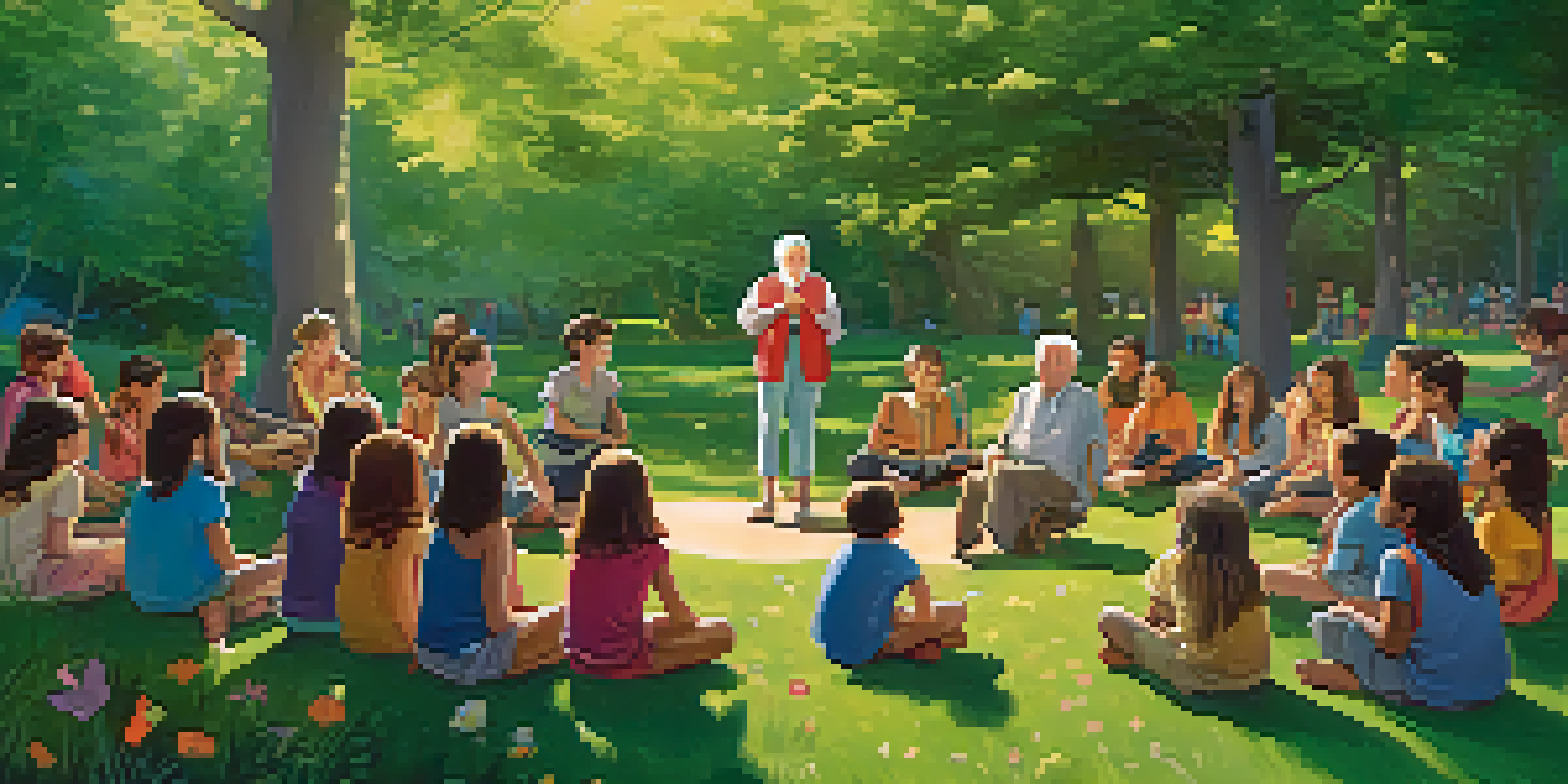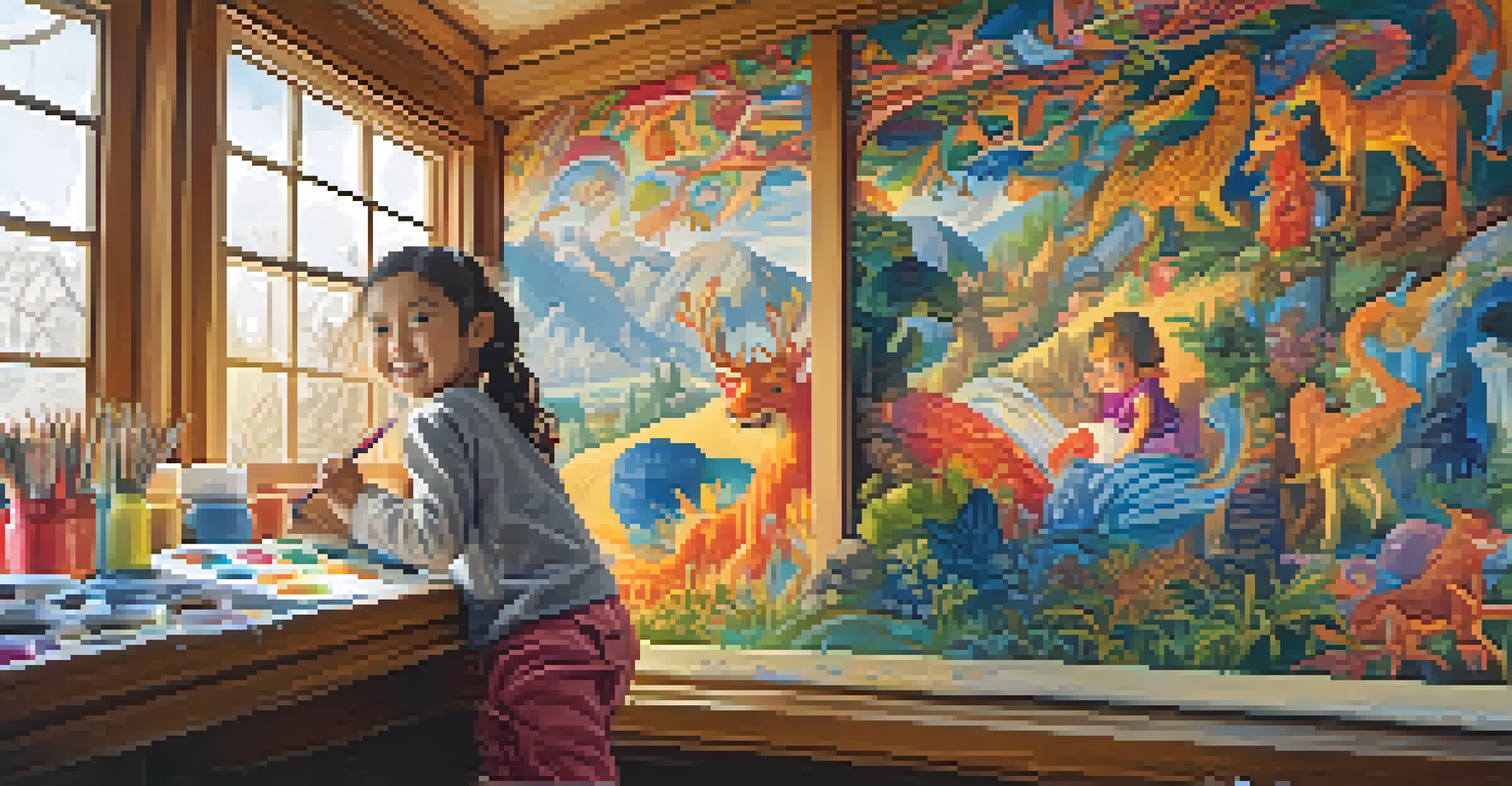The Role of Folklore in Children's Art and Storytelling

Understanding Folklore and Its Significance
Folklore encompasses the traditional beliefs, customs, and stories that have been passed down through generations. It's a tapestry of culture that reflects the values and experiences of a community. For children, engaging with folklore provides a window into diverse worlds, sparking their imaginations and helping them connect with their heritage.
Folklore is the living tradition of a culture, and it is through stories that children learn the values and beliefs of their community.
When children listen to folklore, they absorb the lessons and morals embedded in these tales. These stories often feature relatable characters, making it easier for young minds to grasp complex themes like bravery, kindness, and resilience. This not only nurtures their emotional intelligence but also encourages critical thinking as they relate the narratives to their own lives.
In a world increasingly dominated by technology, folklore serves as a grounding force. It reminds children of the power of oral storytelling and the importance of community bonds. As they engage with these age-old tales, they learn to appreciate the art of storytelling and its role in preserving cultural identity.
Folklore as Inspiration for Artistic Expression
Children's art often draws inspiration from the stories they hear, and folklore is a rich source of creativity. Whether it’s a drawing of a mythical creature or a painting depicting a famous folktale, folklore allows children to explore their imaginations. This artistic expression not only enhances their creativity but also helps them to process and understand the narratives they encounter.

Creating art based on folklore can also foster a sense of identity in children. When they create something that reflects their cultural background or the stories of their ancestors, it instills pride and a sense of belonging. This connection can be empowering, encouraging children to share their artistic creations with others, further enriching the communal experience.
Folklore Cultivates Cultural Identity
Engaging with folklore helps children connect with their heritage, fostering pride and a sense of belonging.
Moreover, folklore-inspired art can be a powerful tool for education. Teachers can use these artworks to spark discussions about cultural diversity, history, and ethics. This multi-dimensional approach to storytelling through art helps reinforce the messages contained in the folklore, making learning both fun and impactful.
Storytelling Techniques in Folklore
Storytelling in folklore is often characterized by its vivid imagery and engaging narrative style. These techniques captivate children's attention, making them eager to listen. By employing methods like repetition, rhythm, and suspense, folklore transforms storytelling into an interactive experience that resonates with young audiences.
Stories are the windows through which we view our world, and folklore opens those windows to diverse cultures and ideas.
When children hear these tales, they learn the art of storytelling themselves. They pick up on the rhythm and flow, which can inspire them to craft their own stories. This practice not only enhances their language skills but also boosts their confidence as they share their narratives with peers and family.
Additionally, storytelling techniques in folklore often incorporate audience participation. Children are encouraged to join in, whether by repeating phrases or acting out scenes. This collaborative aspect not only strengthens their social skills but also makes storytelling a joyous and shared activity.
The Role of Cultural Identity in Folklore
Folklore is a powerful tool for expressing cultural identity, particularly among children. As they immerse themselves in the stories from their own backgrounds, they gain a sense of belonging. This connection fosters pride in their heritage and encourages them to explore and share their culture with others.
In multicultural societies, folklore becomes a bridge for understanding diverse perspectives. Children learn about different traditions and beliefs through stories from various cultures, which nurtures empathy and acceptance. This exposure can help combat stereotypes, fostering a more inclusive mindset from a young age.
Art and Folklore Spark Creativity
Children's artistic expression inspired by folklore enhances their creativity and allows them to process cultural narratives.
Moreover, celebrating cultural identity through folklore can empower children to advocate for their own narratives. By sharing their unique stories, they contribute to the wider tapestry of collective cultural heritage, enriching the community as a whole. This exchange of stories highlights the beauty of diversity and the importance of preserving cultural legacies.
Folklore and Moral Lessons for Children
Many folktales are rich with moral lessons, making them an excellent resource for teaching important values. Stories often illustrate consequences of actions, helping children understand concepts like honesty, kindness, and fairness. These lessons resonate deeply, influencing their behavior and decision-making in everyday life.
For instance, the tale of 'The Boy Who Cried Wolf' teaches the value of honesty, while 'Cinderella' emphasizes kindness and resilience. By hearing these stories, children can reflect on their own actions and learn to navigate their social environments more thoughtfully. This understanding can lead to more compassionate interactions with their peers.
Additionally, discussing the moral implications of folktales with children encourages critical thinking. As they analyze characters' decisions and the outcomes of their stories, children learn to question and reflect on their values. This process not only cultivates their moral compass but also prepares them to face real-life dilemmas with confidence.
Folklore and Imagination in Children's Play
Folklore ignites children's imaginations, transforming their play into adventures inspired by stories. When children enact folktales, they immerse themselves in the characters and themes, allowing creativity to flourish. This imaginative play fosters problem-solving skills and encourages collaboration as they navigate various narratives together.
Through role-play, children can explore different perspectives and experiences, which is essential for developing empathy. For example, acting out a story about a hero can help them understand bravery, while playing a character that faces challenges teaches resilience. This experiential learning reinforces the morals and lessons found in folklore.
Folklore Teaches Moral Lessons
Many folktales convey important moral lessons, guiding children in understanding values like honesty and kindness.
Moreover, folklore-inspired play can facilitate social interaction, as children often share and build upon each other's stories. This collaborative storytelling promotes communication skills and strengthens friendships, creating a supportive environment for personal growth. In this way, folklore becomes not just stories, but a vital part of children's social fabric.
The Future of Folklore in Children's Storytelling
As we move into an increasingly digital age, the role of folklore in children's storytelling is evolving. Technology offers new platforms for sharing traditional tales, from animated films to interactive apps. This modern approach can enhance engagement, making folklore accessible and appealing to a new generation of storytellers.
However, it’s essential to maintain the essence of these stories amidst the digital transformation. Educators and parents can play a crucial role by encouraging children to explore both traditional and modern interpretations of folklore. This balance ensures that the core values and lessons remain intact while adapting to contemporary contexts.

Looking ahead, fostering a love for folklore in children will be vital for preserving cultural heritage. By encouraging them to create their own stories inspired by folklore, we nurture a new generation of storytellers. This ongoing cycle of storytelling will keep folklore alive, ensuring its relevance in shaping the values and creativity of future generations.